All the tools, none of the price
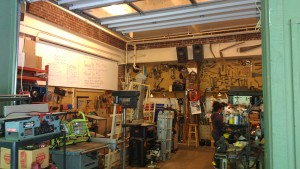
The tool library workshop space
As I mentioned previously, my wife and I clearly bought too much house when we moved into our current home. We paid $625,000 in 2008 in a collapsing market, thinking we totally scored. Unfortunately we didn’t wait quite long enough as home prices continued to decline, putting our potential sales price well below our purchase amount. (We’re about back to even now, not including commissions, interest and work we’ve done to it.)
This mid-century classic home is built like a tank and is the first home I’ve owned with completely straight and plumb walls. It has a warm, cozy feeling throughout and has a classic layout that makes most areas of the home quite usable. It has a lovely view of the Puget Sound and beautiful Vashon Island.
But, as always with real estate, there have been a few issues. The upstairs and downstairs bathrooms were both shot. The kitchen had been remodeled in the 80s or 90s and was poorly done. We’ve replaced all the windows and switched the giant, dirty oil furnace for a new, natural gas model. We almost immediately remodeled the upstairs bathroom and rushed to redo the kitchen last year before Pretired Baby showed on the scene.
As we became more serious about getting to our full pretirement as soon as possible, however, we made some abrupt spending cuts and looked with some dismay at the money we’d put into this house. If we had bought a totally adequate $400,000 home and put the difference into our pretirement accounts, we’d be just about there. Whoops! It’s a lesson I hope anyone thinking about buying a home can learn from me and avoid their own mistake.
So we developed a strategy to get out of our situation and still reach our pretirement objectives. Without diverting to a whole post on our house situation, we decided we need to make some prudent updates to this house to position it for eventual resell at a higher price (hopefully in an appreciating market as well). One of the tactics we came up with is to update our open and awkward basement layout to add two more bedrooms (will function as a storage room and an office for us) and to update the completely disgusting downstairs bathroom. That should let us sell for $20,000 to $30,000 more. Note that we may even downsize into a rental for a few years before we sell as part of a grander plan we have cooking.
Break out the tools
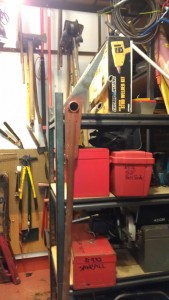
Tools
Thirteen years ago when I bought my first home, I didn’t even own a hammer. I always wondered how old men always seemed to know how to fix stuff on houses. Now I know. After owning half a dozen pieces of property over the years, I have acquired a massive collection of tools. My operating plan for tools has been this: Don’t buy any tool until you absolutely need it. When you need the tool, buy the best quality tool that will fit your needs and repeat as needed.
Projects take much longer and are more dangerous if you don’t use the proper equipment and as much as possible I’ve tried to avoid buying cheap, junk tools because they fail too quickly. Those tools (**cough** HarborFreight **cough**) are basically disposable, which is usually more expensive in the long run. There are a few exceptions to that rule, particularly related to tools that I am pretty sure I’ll never need again. And while renting tools can be a great option, it’s very often cheaper to buy these days, depending on how many hours you’ll need it.
Enter the Tool Library
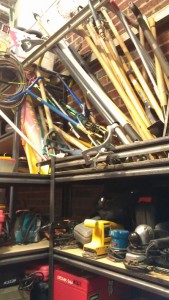
More tools
Today, though, I have another option. I had the opportunity to help, in a very minor way, launch a local “Tool Library” in our community a couple years back. It was a project put together by Sustainable West Seattle, a thriving nonprofit where I served on the board of directors for a few years.
The concept is simple: Instead of every person in the neighborhood storing, say, a pressure washer in their garage for 364 days per year, these tools are centralized and checked out as needed. There are other benefits, too. The group loans tools out en masse to community groups doing work in the area. For example, this this recent project where a garden was created to help a local food bank. (Now hopefully the food bank will be able to offer more fresh food in addition to the more processed fare so often donated.) In addition, tools are available to the community in times of natural disaster, with shovels, axes and saws available as needed.
Nowadays there are even classes to learn how to take on various projects and there is a rentable workshop space with some larger tools.
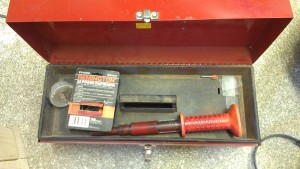
It came with extra nails — sweet!
The tools came from donations and from some purchases using start-up funds received via some government grants and private donations. Many of the initial purchases were rounded up during the massive community-wide garage sale that occurs here every year. Many of those were picked up for just a dollar or two with many more just being given freely as people learned about the concept.
Since I already had such a massive tool collection and haven’t been doing as many home projects lately, I haven’t really needed to borrow anything since we started the tool library. But since we decided to kick off our basement project, I did my first check-out last week.
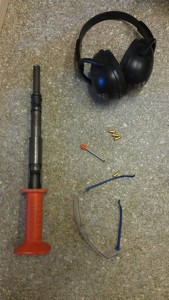
Everything you need to attach wood to concrete
At first I had forgotten it was even there! Needing to attach my walls to the concrete floor of my basement, I had gone in search of a powder-actuated tool. This tool fires a nail into concrete with what is basically a .22 bullet shell. I first checked with family (lots of construction folks in my family) to see if anyone had one I could borrow. No, it’d been loaned out to another family member and was now lost. Next I checked the prices over at Home Depot. Wow, $559 for the Hilti DX 36. Looks sweet! Old me might have just went down and bought that baby on the spot. Or more likely one of the cheaper versions since I won’t need it much after these walls are up. Like this one for $22. Plus I’d need to buy nails and shells. There was nothing decent on Craigslist.
But then I remembered: I have a tool library right here in my neighborhood! I even helped with the launch! I checked the inventory and sure enough, there it was, a Remington Powder Actuated Tool just like I needed. For the low, low cost of FREE. When I got it home I found it even had leftover shells and nails in the kit. Score!
It was busy at the Tool Library while I was there. Someone was loading their car with a load of rakes and shovels to attack a spring project while another person was returning a small rototiller. A couple folks were using the rentable shop space.
Now I know some of you are thinking: “Well I don’t need a Tool Library because I never need tools. I don’t even own a house!”

The embedded nail
Sorry, but we’ve got you covered, too! In addition to having tools available for community projects, the definition of “tool” has been expanded as well. Available are canning tools, a cider press and even books. Wait, books at a library? Mind=blown! There has even been talk of having some loaner dishes available for banquet events and even some sound system equipment or projectors for meetings. We’ll see what happens as it grows.
There really is something for everyone. Do you ride a bike? Check out the bike repair tools! Need to move something heavy? Or just concerned about Zombies? We’ve got you covered. It’s a pretty cool concept. Check around. You may have one in your community as they’ve been sprouting up in recent years. If not, why not help start one? Our team has put together a sweet starter kit to help you get going.
So how did my powder actuated tool loan work out? Awesome! I started by framing in the walls, getting them all dialed in just the way I want. After YouTubing how to use the tool (these donated tools often have no instructions with them), I was ready to go. You insert the nail into the barrel end. Then a cartridge (the “bullet”) is placed in the upper section. You press down hard where you want the nail to go and whap with the hammer. It pops like a gun going off and your nail is safely embedded into the concrete. A few more and the wall is totally solid. The basement is looking awesome so far. I just have a few more walls to go and I’ll be well on my way to a home that’s ready to rent, sell or just enjoy!
Anyone else have a tool library in their community? If there was one available, would you use it?








